If you want to traverse Spain's famous pilgrimage with celiac disease, here's how to hike the Camino de Santiago gluten-free!
This post may contain affiliate links. Please see my disclosure page for more information. Thanks!

While studying abroad in Spain, I remember seeing actual pilgrims on their camino journey walk by us with shells on their backpacks. I never imagined that ten years later, I would be one of them!
In 2019, Dylan and I spent six months backpacking around the world. After trekking the Inca Trail in Peru, and the Annapurna Base Camp Trek in Nepal, we decided to finish our trip with another epic hike along Spain's famous pilgrimage- the Way of St. James, or El Camino de Santiago.
We completed two weeks (about ⅓) of the Camino, hiking approximately 175 miles. It was challenging, rewarding, exhausting, and exhilarating. We hope to one day return to Spain to finish the rest of our journey all the way to the endpoint of Santiago de Compostela.
In general, hiking the Camino de Santiago gluten-free with celiac disease was more physically challenging than culinarily challenging. Picnic lunches, gluten-free groceries, and having a kitchen made our journey a lot easier. I did not have any gluten-related issues in our entire two-week journey.
If hiking is something you are passionate about, but you also have celiac or follow a gluten-free diet, this guide will tell you what to expect when hiking the Camino - how to prepare, what to pack, and how you too can have a safe Camino journey.
¡Vamos!
Camino de Santiago Gluten-Free Travel Guide

- Camino de Santiago Gluten-Free Travel Guide
- About The Camino de Santiago
- Our Journey on the Camino del Norte
- Spain's Food Culture: A Quick Summary
- Celiac Disease & Gluten-Free Food in Spain
- Spanish Restaurant Card
- Tips For Eating Gluten-Free on the Camino de Santiago
- What To Pack For The Camino De Santiago
- Gluten-Free Meal Ideas For The Camino
- Gluten-Free Supermarkets on the Camino
- How to Eat Gluten-Free At Albuerges On the Camino
- The Reality of The Camino: When Things Get Tough
- Final Thoughts: Hiking the Camino de Santiago Gluten-Free
- Looking for more celiac travel posts?
About The Camino de Santiago
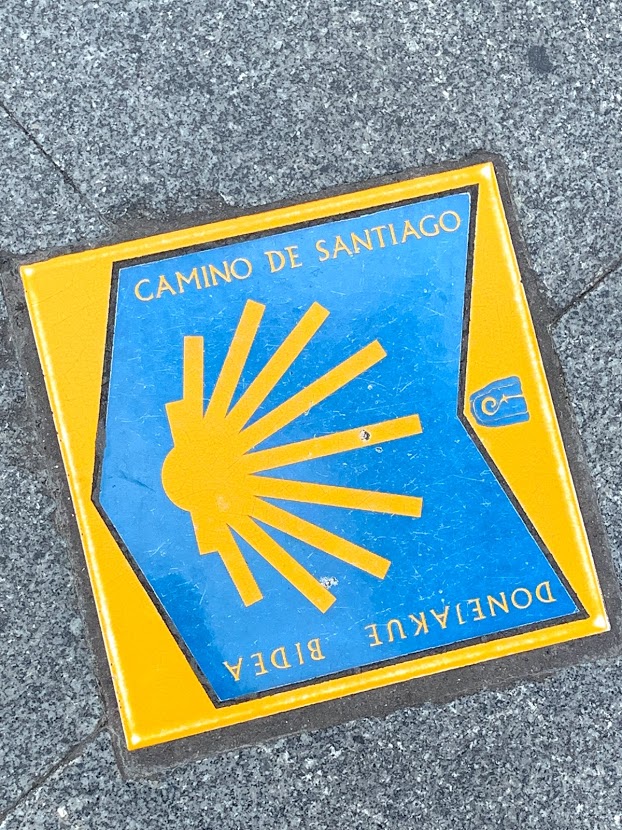
The Camino de Santiago, or way of St. James, is a series of ancient pilgrimage routes leading to the tomb of St. James in the northwest corner of Spain - in the region of Galicia. Santiago is the Spanish name for James, and Camino comes from the verb caminar, meaning to walk.
There are multiple routes leading to the Cathedral of Santiago de Compostela, where St. James is said to be buried. Some begin in France, others in Portugal or Spain. The most popular routes, such as the Camino Francés and Camino Norte, are roughly 500 miles long.
Some people complete the route in a month, others choose to complete sections of it at a time. Hikers on the camino are called peregrinos (pilgrims) and follow the symbol of la concha, the shell, usually in bright yellow, to guide their path.
Our Journey on the Camino del Norte

Since we had a limited amount of time, Dylan and I decided to complete two weeks of the Camino. We chose the Northern Route to enjoy the coastline, see more of Northern Spain (a region I hadn't spent much time in during my study abroad). And it did not disappoint.
Walking along the coastline for the majority of our trip was breathtaking. When I felt like I couldn't walk another step, the views of the beaches, the water, the farms, and the green pastures kept my mind in a good place to keep going.
Our journey began in Irun, on the border of France/Spain. From here, we hiked all the way to Santander over a two-week period.
Dylan was my champion on the Camino. He carried more weight than I did on his back - usually just items from my backpack to lighten my load. Our hiking boots gave us such terrible blisters the first two days that we abandoned them for our thick Teva & Chacos sandals with socks. Not ideal, but better than blisters.
Spain's Food Culture: A Quick Summary

The Spanish eat a predominantly Mediterranean diet, which has been known to provide multiple health benefits. While the regional foods may vary, Spain consumes large amounts of olive oil, fish, and fresh vegetables, along with grains such as potatoes and rice. Common dishes throughout the country include paella, tortilla de patatas, and a variety of tapas (called pintxos in the Basque region). Red wine, olives, cured ham, and sheep’s cheeses are also found on many menus. Coffee is enjoyed in small cups.
Spaniards typically enjoy a small breakfast. It’s best to hold out for lunch, the biggest meal of the day, which is eaten around 2 PM. Spanish families eat much later in the evening, around 9 or 10 PM, or even later. Don’t expect to go out to dinner around American times of 5 or 6 pm – you’ll find most places are serving tapas. Have a glass of wine and small plates of items like Spanish olives, patatas bravas, jamón serrano, maybe even some manchego cheese.
Celiac Disease & Gluten-Free Food in Spain
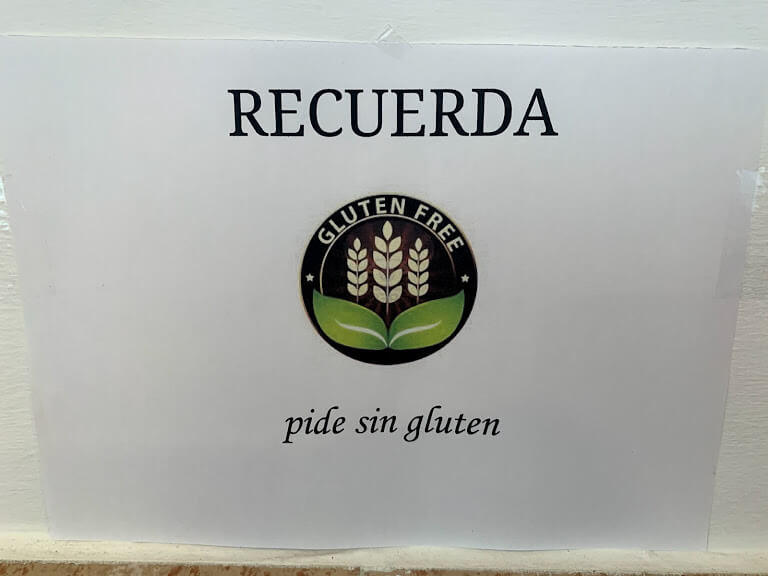
Celiac disease is common in Europe, just like the United States. Many restaurants today have the “F.A.C.E.” blue sticker in their windows, on signs, or on menus. It stands for Federación de Asociaciones de Celíacos de España – the Association of Celiacs of Spain. If you see this, it’s a sign that a particular restaurant has been deemed safe for those with celiac disease.
The awareness surrounding celiac disease in Spain has improved in the last decade. When I lived here in 2010, hardly anyone had any idea what celiac disease or gluten was.
Don’t speak Spanish? No problem!
Invest in a detailed restaurant card in Spanish to explain your gluten-free needs!
Spanish Restaurant Card

Language barriers can be one of the biggest challenges when traveling – especially when you have celiac disease. Be prepared to eat gluten-free on the Camino with your best gluten-free travel tool: a gluten-free restaurant card in Spanish!
This Spanish restaurant card has been carefully written and translated by a local to be sure you are completely understood when eating in restaurants, cafes, or shops in Spain.
As a Spanish teacher, I can tell you that speaking with proper colloquialisms, grammar, and vocabulary makes a big difference in comprehension. A restaurant card translated properly into the local language allows your host, especially at an albergue/hostel, to know what foods you can and cannot eat, and how the preparation of your food is critical to your health and safety.
If you decide to not purchase a restaurant card, be on the lookout for “sin gluten” on menus, restaurants, and products, meaning “without gluten”, and even “sin T.A.C.C.” – the label for gluten-free products also used in Argentina. You can also prepare your hosts at your albuerges by saying "Soy celiaca/celiaco."
Tips For Eating Gluten-Free on the Camino de Santiago

The great part about the Camino is that it's very easy to do with celiac, as long as you have:
- A grocery store nearby (and it's OPEN)
- An albergue/hostel with a kitchen (and pilgrims can use it)
Now, a few words about each of these items.
First, grocery stores of course are going to present in almost every town you pass. However, some small villages, especially on the Northern Route of the Camino, are closed on Sundays. Plan accordingly! Don't get stuck (like we did one day) with only Nutella and chips for dinner.
Second, if your hostel or albergue has a kitchen available, make sure it is available to peregrinos. Most of ours were, but on the occasion, you stay somewhere where your food is prepared for you, you'll want to double-check.
What To Pack For The Camino De Santiago

Click here to view all of the items & brands I recommend for a gluten-free backpacking trip!
The key to making hiking as easy as possible on the Camino is to make sure you aren't carrying a lot of weight on your back.
But you will want to save room for a few things to make life easier.
-A solid backpack with plenty of storage and good support. The smaller the better.
-A loaf of gluten-free bread. Don't bring this from home - you can find them at any local supermarket.
-Jar of peanut butter/nutella, for easy sandwiches.
-Portable & small gluten-free snacks (granola bars, dried fruit, crackers). You can bring them from home or buy them at the local supermarket.
-Your own reusable utensils (we had a small pack we brought everywhere)
-Small soap/laundry detergent. You'll be washing and re-wearing the same outfits every day!
-Reusable water bottle - hydration is so important! You'll find multiple fountains and water stations along the Camino for you to refill often.
-Your pilgrim passport - you will receive this upon the start of your journey, and get it stamped in each village you pass. This will also give you access to stay in albergues where regular tourists are not allowed.
-Sleep Sacks - These are small, light, and portable. An easy lightweight way to sleep if there aren't any blankets available at very basic albergues. (We stayed in a convent one night where our sleeping situation was a mattress, and nothing else.)
-Eye Mask, Ear Plugs, and Headphones. Don't skimp on these. You'll be sleeping in the same space with lots of other people. There will be snoring. Make sure you have a way to drown out the noise and light.
AND OF COURSE:
-First Aid Kit: Bandaids and moleskin to help prevent blisters, but they'll happen anyway.
Also, don't be surprised if you lose a toenail. We both did.
Gluten-Free Meal Ideas For The Camino


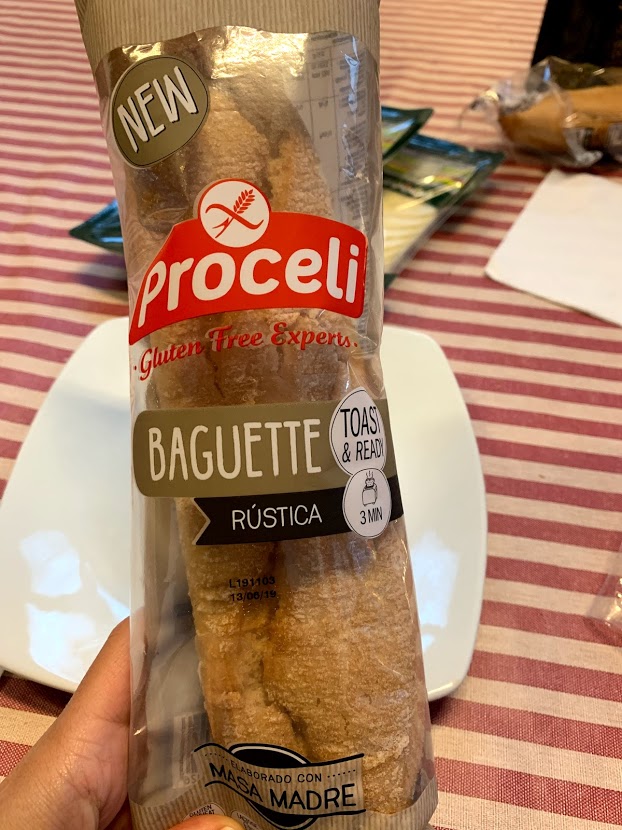
Here's what our daily meals looked like on the Camino.
Breakfast: Breakfast was usually included in our albergue stay and we were up around 6:00 AM every day. I had whatever I could - usually fresh fruit and yogurt. I would also take another piece of fruit for my snack that day.
Snack: By mid-morning, I was usually starving, so I'd snack on the fruit I brought from breakfast, or another small snack in my bag. Usually it was crackers, granola bar, or dried fruit. Sometimes, if I was lucky, I'd grab patatas aioli, like the ones you see above from Las Fritas in Bilbao.
Lunch: Dylan and I had lunch on our own. We usually stopped at a grocery store for some salami, cheese, crackers, and fruit, or have sandwiches we made the day before. We'd stop for a picnic when we got tired and usually in the most beautiful spots.
Dinner: We usually made this ourselves at our hostel/albergue. Simple meals, like pasta and salad were easy to make. Sometimes we'd pick up tortilla de patatas and some jamon at a local shop to enjoy back at the albergue.
On occasion, when we could, we dined out at a restaurant in one of the towns, and I would stick to simple meals: eggs, chicken, and potatoes. And in one village, we even managed to find gluten-free Domino's pizza.
Gluten-Free Supermarkets on the Camino

The most common supermarkets you can expect to find on the Camino are the chain supermarkets in Spain, such as Mercadona, Eroski, Lidl, Carrefour, and Día. I've been in each of these stores and can say that they each have a solid selection of gluten-free products.
Typically, there will be a dedicated section/aisle/area for gluten-free products. Be sure to also check the freezer section for additional quick meals, like this pizza I found at an Eroski supermarket in Deba, Spain.
How to Eat Gluten-Free At Albuerges On the Camino

Sometimes albergues will offer a meal with your stay for a few euros. One of our favorite nights on the Camino was in fact one of these group dinners at Albergue Tu Camino in Ontón. We had developed a small Camino family with some fellow pereginos that had been on the trail with us for over a week.
At this table alone, people were speaking English, Portuguese and Spanish, but we all understood each other. The bond that you form with your fellow peregrinos is something truly special, and this was a night Dylan and I will never forget. We drank wine, sang songs, told jokes, and laughed the entire time. I'm still in touch with people at this table - two years later!
Albergue Tu Camino offered a dinner for pereginos - 5 Euro per person. Upon arrival, I had no idea what the meal would include and was extremely hesitant until I spoke to the host. She only spoke Spanish, and I explained to her in Spanish that I had celiac. Without missing a beat, she said:
"No te preocupes!"
Translation: Don't worry.

She took me into the kitchen and showed me exactly what they were preparing for dinner. For 5 euros, the meal included unlimited red wine, salad, a vegetarian dish, and dessert. There was no flour in anything except the dessert, and she said they'd bring me fruit instead.
That evening, Dylan and I had a delicious meal, and the best part was when the host arrived with a box of gluten-free crackers. She noticed when the bread was placed on the tables that obviously wouldn't work for me and brought out a special box of crackers they keep for celiacs, just in case.
It felt like a 5-star treatment after hiking all day!
We ended the evening by leading everyone in song. A tune called "Peregrinos" to the tune of La Bamba, which Dylan played on guitar.
The Reality of The Camino: When Things Get Tough

I'm not going to lie to you friend.
There were so many times on the Camino I wanted to quit. It was hard, and we only walked ⅓ of it.
On our first day, we walked 15+ miles. By the end of it, my feet were raw with blisters. I switched to thick socks and sandals to alleviate the pain.
The next few days, my backpack was way too heavy to navigate the hills, and Dylan had to take a lot of the weight.
I am an experienced hiker. But I was not used to what it felt like to walk with a backpack for 10+ miles a day.
About a week into the journey was a big turning point. The previous night, a fellow pilgrim snored SO LOUDLY I was awake literally, all night. My earplugs did nothing.
The following day, I was absolutely miserable. I had a cold from not sleeping, there was only bread at breakfast, and we walked outside to discover it was raining.
I just couldn't do it.
Dylan said, "Okay, let's take a break."
We hopped on a bus to Bilbao, the closest city about 30 minutes away.
As I sat on the bus, crying silently, I felt like an absolute failure. I felt defeated and so guilty for stopping.
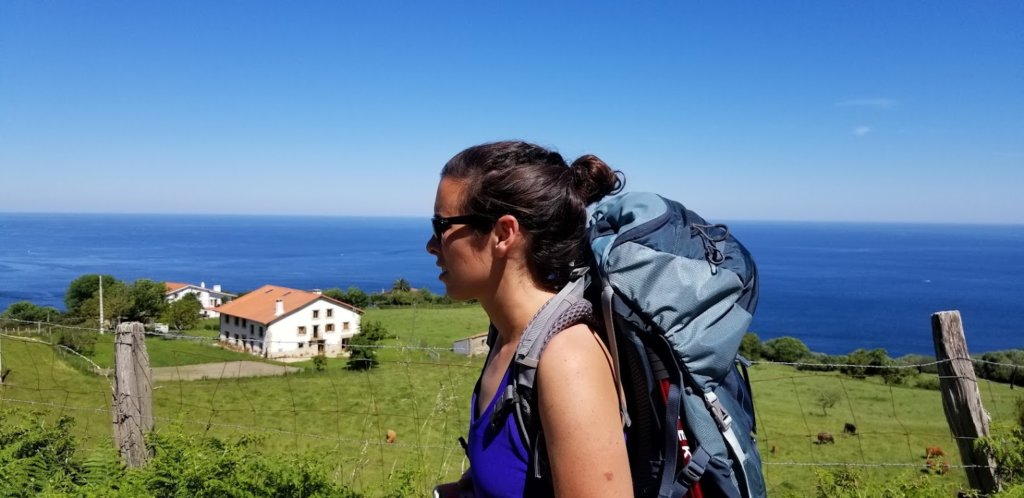
But Dylan was patient and reminded me that we weren't quitting. We didn't need to keep going at 150% if that pace wasn't working for us.
That day, we arrived in Bilbao and booked a hostel for 2 nights. I took a shower, napped, and rested. We went to the grocery store and got ingredients to make dinner. And I realized that he was right.
Taking those 2 days reinvigorated me. I realized that it was okay to slow down and take a break.
We returned to the Camino well-rested and continued our hike at the next village, where we met up with our Camino "family" - the people we had been walking with the previous week.
I was so excited to see them and felt home once again.
And for our second week on the Camino, we alternated between staying in albergues and small hotels, so we could get better sleep when we needed to. It helped!
I'm sharing that part of our Camino journey to remind you of the same thing.
If you are struggling to hike the Camino de Santiago gluten-free: take a breath.
Slow down if you need to. Take breaks, and be gentle with yourself.
This is ESPECIALLY important when you are gluten-free. You want to give yourself grace and compassion in case something does happen, so you can recover and feel better.
The Camino is a journey, and it can bring you to your breaking point.
But the beauty of it is that you learn what you are capable of.
Final Thoughts: Hiking the Camino de Santiago Gluten-Free

I still can't believe I actually made it all the way to Santander. But I did successfully complete ⅓ of the Camino de Santiago gluten-free!
Hiking the Camino was challenging. But truthfully, eating gluten-free was the easiest part!
With the multitude of picnic lunches, preparing your own meals at albergues, the presence of gluten-free products in grocery stores, and increased awareness of celiac disease in Spain, I was pleased with my food on our two-week hike.
And I never got sick with stomach problems.
Looking for more celiac travel posts?
Avoid these five mistakes when dining out with celiac disease!
Flying somewhere and worried you'll be starving in an airport? Not to worry, this post on flying with celiac disease has you covered!
Do you have celiac AND IBS? I do too. Here's how I manage both when traveling.
Get my gluten-free travel guides to Boston, New York, Madrid, Buenos Aires (plus many more) here!

Dylan and I hope to return to Spain to finish our journey, picking things up in Santander and continuing all the way to Santiago de Compostela. Now that I know what to expect, I imagine Part 2 of the Camino will be better than Part 1. Buen Camino a todos.
Have you ever hiked the Camino de Santiago gluten-free, or do you plan to one day?
What was your experience like as a peregrino sin gluten?
Let me know what you think of this gluten-free guide!


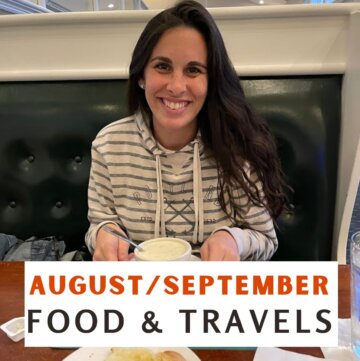
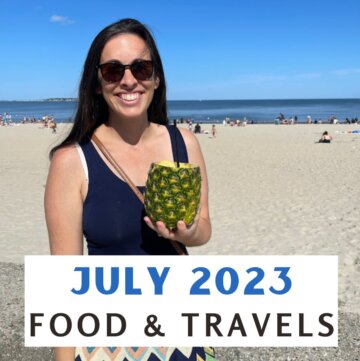
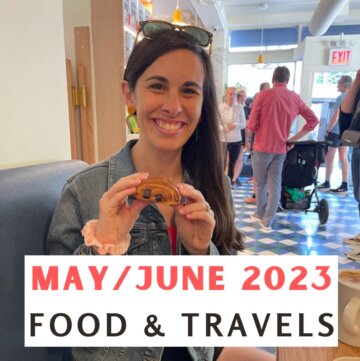
Tim Vranizan says
Thank you so much for this article and sharing your experience. I am just beginning to prepare for El Camino de Frances and I have celiac. I have been a bit concerned about my diet on the pilgrimage but you have put my mind at ease. Thanks.
Jennifer Fitzpatrick says
Hi Tim! You are so welcome, and buen camino to you. I will say the smaller towns were the most challenging, so it will be a lot of planning ahead, packing snacks, and preparing food for yourself. If you speak Spanish, don't be afraid to ask your hosts if they can accommodate you.